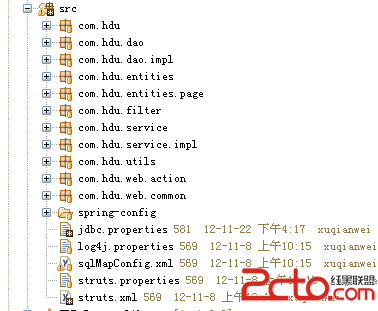我到公司 搞的第一個項目的用的框架用的就是這個,所以我已經自己試著自己搭建,其實跟三大框架搭建也差不多

這是我們公司的包結構,包結構不用多說,大家都看的懂,jdbc.properties這個配置文件是在spring裡面要用的訪問數據庫的配置
log4j是一個日志的配置文件,說明錯誤的一些還有訪問的一些信息寫入到哪裡
sqlMapConfig配置文件是ibatis的總配置文件, 下面寫的就是有哪些mapping配置文件,放置的位置就在和entities包下,每一個包寫一個配置一個
下面寫的就是有哪些mapping配置文件,放置的位置就在和entities包下,每一個包寫一個配置一個
如果,要涉及要多表查詢,就要再創建一個類就好,把2張表中用到的屬性,插入到這個類裡面
spring-config這個文件夾下放的就是spring的幾個配置文件
一個寫的就是action的創建,一個是biz層的創建,還有就是DAO
其實struts的action可以用spring來創建,用的就是加了一句話
<constant name="struts.objectFactory" value="spring" />
這些包結構配置後之後就是配置web.xml
就是告訴tomcat哪些是struts配置文件,哪些是spring配置文件,讓tomcat啟動的時候,就可以創建了
<?xml version="1.0" encoding="UTF-8"?>
<web-app xmlns:xsi="http://www.w3.org/2001/XMLSchema-instance" xmlns="http://java.sun.com/xml/ns/javaee" xmlns:web="http://java.sun.com/xml/ns/javaee/web-app_2_5.xsd" xsi:schemaLocation="http://java.sun.com/xml/ns/javaee http://java.sun.com/xml/ns/javaee/web-app_2_5.xsd" id="WebApp_ID" version="2.5">
<display-name>HD_U</display-name>
<context-param>
<param-name>webAppRootKey</param-name>
<param-value>HD_U.root</param-value>
</context-param>
<listener>
<listener-class>org.springframework.web.util.Log4jConfigListener</listener-class>//添加日志類的監聽
</listener>
<listener>
<listener-class>org.springframework.web.context.ContextLoaderListener</listener-class>//spring的監聽類
</listener>
<context-param>
<param-name>log4jConfigLocation</param-name>//日志類監聽的初始化的參數,告訴配置文件在哪裡
<param-value>classpath:log4j.properties</param-value>
</context-param>
<filter>
<filter-name>struts2</filter-name>//struts2的單控制器
<filter-class>org.apache.struts2.dispatcher.FilterDispatcher</filter-class>
</filter>
<filter-mapping>
<filter-name>struts2</filter-name>
<url-pattern>/*</url-pattern>
</filter-mapping>
<context-param>
<param-name>contextConfigLocation</param-name>//spring的監聽類告訴spring配置文件在哪裡
<param-value>classpath*:/spring-config/applicationContext*.xml</param-value>
</context-param>
<welcome-file-list>
<welcome-file>index.html</welcome-file>
</welcome-file-list>
<servlet>
<description></description>
<display-name>InitServlet</display-name>
<servlet-name>InitServlet</servlet-name>
<servlet-class>com.hdu.web.common.InitServlet</servlet-class>
<load-on-startup>1</load-on-startup>
</servlet>
</web-app>